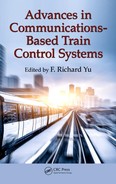
58 ◾ Advances in Communications-Based Train Control Systems
(Continued)
Table 3.1 Advantages and Disadvantages of NDT Methods for Rail and Fastening Parts Inspection
Inspection
Technique Advantages Disadvantages Detection Capability
Manual and
automated
visual
Simple, can be automated, fast,
inexpensive, defective ballast,
reliable in detecting corrugation
Provides information only
regarding the surface of the
component, missing parts,
nonquantitative
Surface breaking defects, rail head
prole missing parts
Liquid penetrant Simple, high resolution, accurate,
very sensitive to small surface-
breaking defects, appropriate for
weld inspection in rails,
applicable to any type of material
that is nonporous
Requires surface preparation,
access to the component’s
surface, qualitative, thorough
cleaning, no permanent record,
only surface-breaking defects
detectable
Small surface-breaking defects
such as fatigue cracks and
corrosion pits
Conventional
ultrasonic
Relatively inexpensive unless
phased arrays are used, capable of
detecting hidden defects and
quantifying both hidden and
surface-breaking defects, can be
applied to any type of material
Local inspection, at high speed
can miss surface defects
<4mmas well as internal
defects particularly at the rail
foot, affected by weather
conditions
Internal and surface defects
including fatigue cracks and
corrosion, no detectable rail foot
defects
Laser ultrasonic Reliable in detecting internal
defects, relatively fast
Can be affected by liftoff
variations of the sensors,
difcult to deploy at high
speeds, expensive
Internal and surface defects, rail
head, web and foot defects

Safe Rail Transport via Nondestructive Testing Inspection ◾ 59
(Continued)
Table 3.1 (Continued) Advantages and Disadvantages of NDT Methods for Rail and Fastening Parts Inspection
Inspection
Technique Advantages Disadvantages Detection Capability
Phased array
ultrasonic
Capable of detecting hidden
defects and quantifying, can be
applied to any type of material
Local inspection, at high speed
can miss smaller surface defects,
can be affected by liftoff
variations of the sensors, quite
expensive
Internal and surface defects
including fatigue cracks and
corrosion, rail head, web and foot
defects
Long-range
ultrasonics
Relatively fast, capable of detecting
large hidden and surface-breaking
defects, can be applied to any
type of material, can inspect long
sections up to several tens of
meters in one go
Only simple geometries can be
inspected, considerable dead
zone, defects need to be
relatively large to be detectable,
signal-to-noise ratio can be
affected by the inspection
conditions
Relatively severe corrosion and
transverse cracks, surface defects,
rail head, web and foot internal
defects
Magnetic ux
leakage
Fast, sensitive to transverse cracks
and corrosion, applicable for
surface and hidden defects
Only ferrous materials, defect
geometry inuences
quantication, parallel cracks
can be missed, requires good
magnetization to avoid
underestimation or missed
defects, bulky equipment
Surface and hidden corrosion and
fatigue cracks, inclusions

60 ◾ Advances in Communications-Based Train Control Systems
Table 3.1 (Continued) Advantages and Disadvantages of NDT Methods for Rail and Fastening Parts Inspection
Inspection
Technique Advantages Disadvantages Detection Capability
Eddy currents Inexpensive, sensitive to
microstructural, electric and
magnetic properties, sensitive to
small defects, applicable to any
conductive material, can operate
at signicant liftoffs
Very liftoff sensitive, inspection
penetration depth and
resolution dependent on
frequency, local inspection,
more efcient for surface and
near-surface inspection, low
resolution in high liftoffs
Surface and near-surface defects
(cracks and pitting corrosion),
general corrosion, microstructural
changes
Alternating
current eld
measurement
Mainly manual system,
inexpensive, sensitive to small
defects, capable of quantifying
depth and length of surface-
breaking defects, can be
automated, can operate at
signicant liftoffs
Only surface-breaking defects,
local inspection, quantication
only possible for fatigue cracks
Surface-breaking defects including
pitting corrosion and fatigue
cracks
Electromagnetic
acoustic
transducers
Inexpensive, noncontact, no
material limitation as long as it is
conductive, can detect both
hidden and surface-breaking
defect, can be local or long range,
can be applied at high
temperature, easy to produce
specic waves and modes
Low signal-to-noise ratio, sensor
requires cooling at high
temperatures, bulky sensors,
liftoff cannot exceed 2mm,
low-speed hi-rail vehicle
(<10km/h)
Surface and hidden defects
including corrosion and fatigue
cracks

Safe Rail Transport via Nondestructive Testing Inspection ◾ 61
Table 3.2 Comparison of NDT Methods for Rail and Fastening Parts
Inspection
Characteristics
NDT Method
Manual and
Automated
Visual
Liquid
Penetrant
Conventional
Ultrasonic
Laser
Ultrasonic
Phased
Array
Ultrasonic
Long
Range
Ultrasonic
Magnetic
Flux
Leakage
Detection
capability
Limited
(surface
only)
High
(surface
only)
High High High
Average
(large
defects
only)
High
(ferrous
only)
High
(near
surface only)
High (surface
only)
High
Detection
resolution
Average High High High High Low Average High High Average
Depth estimation No No Yes Yes Yes Yes Yes Yes Yes Yes
Portability/access High High High
High
High High Low Average High High Average
Couplant
required/surface
treatment/surface
access
No Yes Yes Yes Yes Yes No
Average
(some surface
preparation
may be
required)
No No
Simplicity High High Low Low Average Average Average High Average
Inspection speed Average Average Average Average Average LowHigh High High High
Appropriate for
use in robotic
crawlers (internal
or external)
Yes (AVI)No Yes Yes Yes No Yes Yes Yes Yes
Level of training
required
Low Low High High High High Average High LowHigh
Cost Low Low Average High High High Average LowLow Average
Electromagnetic
Acoustic
Transducers
Alternating
Current Field
Measurement
Eddy
Current
62 ◾ Advances in Communications-Based Train Control Systems
References
1. Signals passed at danger, Oce of Rail Regulation, 2011.
2. Melago, C., and C. A. Catastrophic. Train wreck caused when metrolink engineer
failed to stop, say rail ocials. Daily News (New York City), September 13, 2008.
3. National Transportation Safety Board. Collision of union Pacic railroad train
MHOTU-25 with BNSF railway company train MEAP-TUL-126-D with subsequent
derailment and hazardous materials release, Macadona, TX, June 28, 2004. NTSB
#RAR-06/03, National Transportation Safety Board, Washington, DC, July2006.
4. Oce of Rail Regulation. Train derailment at Hateld: A nal report by the inde-
pendent investigation board, Oce of Rail Regulation, UK, 2006.
5. National Transportation Safety Board. Derailment of Canadian Pacic railway
freight train 292-16 and subsequent release of anhydrous ammonia near Minot,
North Dakota, January 18, 2002. Railroad Accident Report, RAR-04-01, National
Transportation Safety Board, Washington, DC, March 9, 2004.
6. Railway Association of Canada; Association of American Railroads. Algoma Central
Railway, British Columbia Railway, Burlington Northern Railroad, CN Rail, CP
Rail, Norfolk Southern, and Seaboard System Railroad: Advanced train control
systems operating requirements. Railway Association of Canada, Ottawa, Canada;
Association of American Railroads, Washington, DC, April 1984.
7. Detmold, P. J. New concepts in the control of train movement. In Transportation
Research Record 1029, TRB, National Research Council, Washington, DC, 1985,
pp.43–47.
8. FRA, U.S. Department of Transportation. Implementation of positive train control
systems. FRA, U.S. Department of Transportation, Washington, DC, 1999.
9. Moore Ede, W. J., A. Polivka, J. Brosseau, Y. Tse, and A. Reinschmidt. Improving
enforcement algorithms for communications-based train control using adaptive
methods. Proceedings of the 9th International Heavy Haul Conference—Heavy Haul
Innovation and Development, Shanghai, China, 2009.
10. FRA, U.S. Department of Transportation. Positive train control systems. 49
CFR Parts 229, 234, 235, and 236. FRA, U.S. Department of Transportation,
Washington, DC, January 15, 2010.
11. Lee, J.-D., J.-H. Lee, C.-H. Cho, P.-G. Jeong, K.-H. Kim, and Y.-J. Kim. Analysis of
moving and xed autoblock systems for Korean high speed railway. In Computer in
Railways VII, WIT Press, Southampton, MA, 2000, pp. 842–851.
12. Wendler, E. Inuence of ETCS on the capacity of lines. In Compendium on ERTMS,
Eurail Press, Hamburg, Germany, 2009, pp. 211–223.
13. Smith, M. E., R. R. Resor, and P. Patel. Train dispatching eectiveness with
respect to communication-based train control: quantication of the relationship. In
Transportation Research Record 1584, TRB, National Research Council, Washington,
DC, 1997, pp. 22–30.
14. Smith, M. E., and R. R. Resor. e use of train simulation as a tool to evaluate
the benets of the advanced railroad electronics system. Journal of the Transportation
Research Forum, Vol. 29, No. 1, 1989, pp. 163–168.
15. Smith, M. E., P. K. Patel, R. R. Resor, and S. Kondapalli. Quantication of expected
benets: Meet/pass planning and energy management subsystems of the advanced
railroad electronics system (ARES). Journal of the Transportation Research Forum,
Vol.30, No. 2, 1990, pp. 301–309.
..................Content has been hidden....................
You can't read the all page of ebook, please click here login for view all page.
